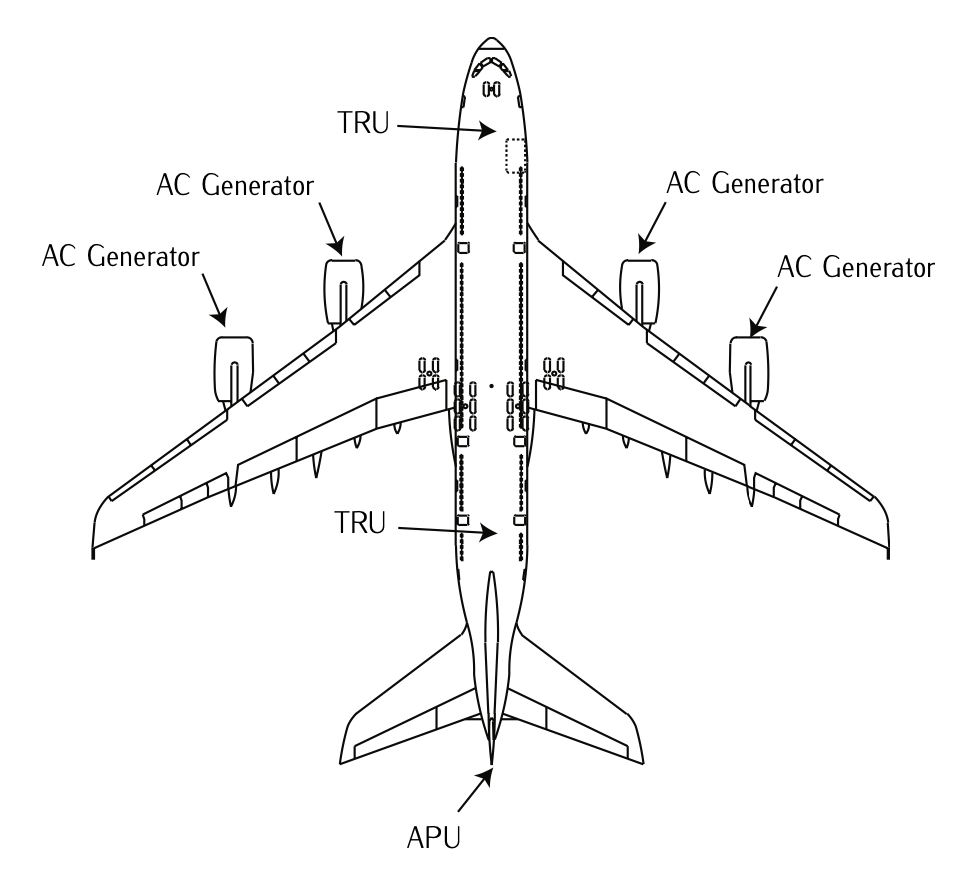5.2.1: Electrical system
- Page ID
- 78131
The electrical system is of great importance. Many elements run with electric energy, e.g: Indicator instruments, navigation and communication equipments, electro-actuators, electro-pneumatic mechanisms, illumination, passenger comfort (meals, entertainment, etc).
The electrical system is formed by the unities and basic components which generate, store, and distribute the electric energy to all systems that need it. Generally, in aircraft the primary source is Alternating Current (AC), and the secondary source in Direct Current (DC). The typical values of the AC are 115 V and 400 Hz, while the typical value of DC is 28 V. Due to safety reasons, the principal elements of the systems must be redundant (back-up systems), at least be double. Therefore, we can distinguish:
- Power generation elements (AC generation).
- Primary power distribution and protection (AC distribution).
- Power conversion and energy storage (AC to DC and storage).
- Secondary power distribution and protection elements (DC distribution).

Figure 5.15: A380 power system components.
There are different power generation sources for aircraft. They can be either for nominal conditions, for redundancy, or to handle emergency situations. These power sources include:
- Engine driven AC generators.
- Auxiliary Power Units (APU).
- External power, also referred to as Ground Power Unit (GPU).
- Ram Air Turbines (RAT).
The engine driven AC generators are the primary source of electrical energy. Each of the engines on an aircraft drives an AC generator. The produced power using the rotation of the turbine in nominal flight is used to supply the entire aircraft with electrical energy.
When the aircraft is on the ground, the main generators do not work, but still electrical energy is mandatory for handling operation, maintenance actions, or engine starting. Therefore, it is necessary to extract the energy from other sources. Typically, the aircraft might use an external source such a GPU, or the so-called Auxiliary Power Unit (APU). The APU is a turbine engine situated in the rear part of the aircraft body which
produces electrical energy. The APU is typically used on the ground as primary source of electrical energy, while on air is a back-up power source.
Some aircraft are equipped with Ram Air Turbines (RAT). The RAT is an air-driven turbine, normally stowed in the aircraft ventral or nose section. The RAT is used as an emergency back-up element, which is deployed when the conventional power generation elements are unavailable, i.e., in case of failure of the main generator or the APU when on air or ground, respectively.
Engine driven generators, GPU, APU, and RAT produce AC current. This AC current is distributed throughout the system to feed the elements of the aircraft that require electrical input, e.g., lighting, heating, communication systems, etc. However, it is also necessary to store energy in case of emergency. The energy must be stored in batteries working in DC. Therefore, the energy must be converted (AC to DC), for which one needs transformation units. The most frequently used method of power conversion in modern aircraft electrical system is the Transformer Rectifier Unit (TRU), which converts a three- phase 115V AC current into 28V DC current. Then the DC current stored in batteries can be distributed by means of a secondary DC distribution system, used also to feed certain elements of the aircraft that require electrical input. Notice that both the generation and the distribution need protection elements (for the case of AC current: under/over-voltage protection, under/over frequency protection, differential current protection, current phase protection) and control elements (in order to regulate voltage).


